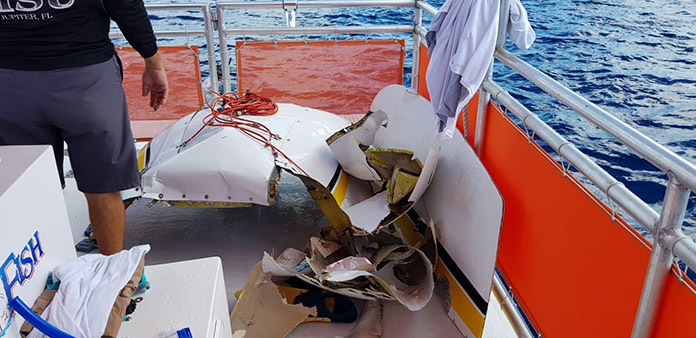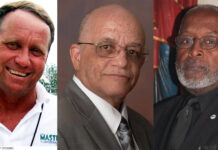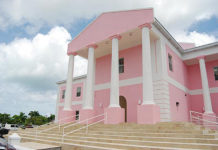
BY: Keith O. Major Jr
NOVEMBER 17
The issues with air accident investigations in The Bahamas involving impact with water are systemic.
This year, unfortunately, has already yielded two (2) instances of air accidents involving impact with water. The first, being January 17th, 2018, off the coast of Mastic Point, Andros and the second November 8th, 2018, near Love Beach, New Providence. Regrettably, in both instances, the recovery of aircraft wreckage was not instantaneous. And also in both instances, volunteers / private citizens facilitated the recovery of significant and/or the most substantial portions of such wreckage. This then begs the question. What is the current state of The Bahamas’ Aircraft Accident Investigation regime?
By way of the Civil Aviation Act, 2016 (CAA 2016), the Minister responsible for Civil Aviation was empowered to establish an Air Accident Investigation Department (AAID). The ambit of this “new and independent” Department, among other functions, is the the conduct of investigations into accidents or serious incidents occurring in or over the territory of The Bahamas. This is inline with the 1944 Chicago Convention, which holds that each State exercises complete and exclusive sovereignty over the airspace above its territory. Following thereon, it is helpful to add that under the Law of the Seas, the territory of The Bahamas, as it is an archipelagic nation, includes all waters situated between the islands constituting its archipelago. As such, both of the aircraft accidents mentioned above, which occurred in Bahamian waters generally between New Providence and Andros, culminated in the territory of The Bahamas.
Specific rescue assets, by custom, are typically engaged in response to an aviation disaster or on suspicion of an aviation disaster involving impact with water, namely: United States Coast Guard, The Royal Bahamas Defence Force (RBDF), and Bahamas Air and Sea Rescue Association (BASRA). However, a review of the CAA 2016 suggests that the overall authority in air accident and incident investigations (inclusive of the function of coordination) rests in the AAID, thus “AAID shall have the power to investigate, or arrange by contract or otherwise for the investigation of, accidents or serious incidents occurring in or over the territory of The Bahamas…”
In reviewing the aircraft accident report relative to the January 17th crash, one is able to glean that the RBDF, ostensibly, and either rightly or wrongly, operates beyond the role of just a rescue asset. This is having regard to the following excerpt from the report by AAID: “The RBDF confirmed [to AAID] that no further searches will be conducted as there was nothing else to be recovered and the parts brought to the shore was all that was found in the debris field.” Firstly, this is concerning as it would appear that the entity placed with conduct of investigations (AAID) should be the entity to determine the duration, extent and parameters of investigations of and at any scene of any air accident.
Secondly, it is also concerning because by way of the discovery of private fisherman, it was later revealed that such a statement was incorrect and that there was in fact more to be recovered.
Fast-forwarding to the most recent November 8th crash, for more than a week now the attention of the country has been gripped by the suspense and hopes of rescue or recovery from the believed air accident scene of an aircraft piloted by Byron Ferguson. Adding to the already involved situation were conflicting reports as to whether or not the aircraft was or was not actually seen the night of the crash by rescue assets.
According to news reports, Assistant Commissioner Leamond Deleveaux went on record to confirm that ‘authorities’ had located the twin-engine aircraft during the search and rescue efforts. However, ‘authorities’ made a decision to suspend efforts the night of and when they returned the next morning were unable to locate the wreckage. It was only when HeadKnowles, an NGO, orchestrated a private recovery effort, that pieces or what is believed to be pieces of the ill-fated aircraft were retrieved from Bahamian waters.
While the matter is still ongoing, what is not clear to most persons considering the incident is, why was the aircraft not retrieved from waters, tagged or otherwise secured, if it was spotted the night of the crash.
Unity of Command
The above examples are drawn in support of the conclusion that such decision-making by ‘officials’ demonstrates a lack of deference to unity of command unto the AAID in instances regarding the salvaging of air accident wreckage. This is concerning because among the entities engaged in aircraft accident salvage and investigations, AAID is the one comprised of aviation technical experts and AAID is the one placed with specific statutory power to have conduct of air accident investigations.
By way of definition, unity of command is the well recognized principle which holds that in joint operations, all parties involved are designated a supervisor to whom they report and receive their directives from at the scene of an incident. This is important as it removes duplication of efforts and any confusion in the coordination of efforts.
Spoliation
Moreover, a key and consequential issue which arises out of the untimely retrieval of airplane wreckage is evidentiary in nature, and is referred to as spoliation of evidence. Spoliation of evidence in the aviation context extends to the loss, destruction, material alteration of or the failure to preserve a writing, record or physical object. Courts when applying this doctrine have had regard to the negligent failure to preserve evidence, even though deemed as unintentional conduct.
Any delay in securing a component part or wreckage of aircraft from waters, may naturally impact the integrity of such parts recovered, as a result of degradation. In turn, this degradation of a wreckage or a complete failure to recover the same may detrimentally affect the ability to perform investigations as to probable causes in an aviation accident. For this reason, where such delay is avoidable, such delay is inexcusable.
Some jurisdictions recognize spoliation of evidence against Third Parties as an independent action under Tort. In such instances, such an action is maintained on the failure of an entity to satisfy its duty to preserve evidence which, in the aviation context, is viewed as arising from the moment an incident occurs.
The recent 2018 Privy Council decision of Bahamasair Holdings Limited v. Messier Dowty Inc. is an example of the importance that securing evidence from an aircraft accident plays in subsequent litigation. This is because, had the evidence in this incident not been secured; or said another way had it been spoliated, the investigators would not have been able to identify the cause of the accident to be a faulty component part. Without such evidence and stated cause of the accident, the Appellant’s (Bahamasair) subsequent litigation against the component part manufacturer would have been directly impacted if not all together thwarted.
In closing, this year’s aircraft accidents involving impact with water, if nothing else, underscore the point that perhaps a second look needs to given to CAA 2016 and more broadly to the aircraft accident and investigation regime in The Bahamas. This is so due to The Bahamas’ positioning in the world of international travel routes and the fact that it is surrounded by vast amounts of water. The Bahamas’ ability to respond to aircraft accidents involving impact with water is of paramount importance from a safety standpoint and also forms a part of its mandate regarding its international civil aviation obligations among States.
Certainly, the appropriate response to this state of affairs is two-pronged: legislative and budgetary. It is legislative to the extent that the unity of command principle needs to be made more explicitly pronounced in the governing legislation. This is to ensure that moving forward any entity entrusted with advising the rescue assets is able to unequivocally render to them the benefit of counsel as regards their parameters, liabilities and obligations.
Secondly, the appropriate response is budgetary in that the rescue assets which are to be coordinated by the leading organization must be equipped with the adequate resources to undertake its task.
Any response other than or short of this, misses the mark and is sure to be ineffective.
#bitesizelaw #stratfordlaw #bahamianlaw?? #aviationlaw #spoliation
– Keith O. Major Jr., LL.M., aviation attorney
What do you say?
If you have any questions, comments or concerns about what I wrote above, feel free to let me know, let’s broaden the discussion. You can also send me an e-mail to keithomajor@gmail.com.







